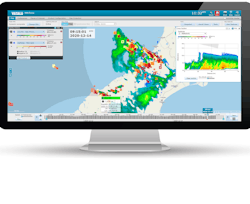Vaisala IRIS Focus displays and analyzes weather information to enable quicker decisions and more accurate precipitation classification. The software brings together a rich information set from weather radar(s), lightning sensors (of a global lightning network) and wind lidars. It needs those three things, then it can make use of the data separately or together.
Phillip Falgoust, product manager of Lightning Networks and Sensors at Vaisala, emphasized IRIS Focus alone cannot address an airport’s weather needs. It is interfaced with Vaisala’s main aviation software, Vaisala AviMet AWOS, for example, which can be customized to detect lightning, runway surface condition, windshear and other severe weather phenomena. With IRIS Focus, users then have a centralized platform to access essential remote sensing equipment needed to measure, analyze and understand severe weather events that may impact the environment.
From understanding oncoming precipitation events to tracking threats associated with wind and lightning, Falgoust said the IRIS Focus software suite includes all the needed functions to support enhanced safety protocols next to mitigating financials losses by minimizing delays.
He shared some important things to note:
• Weather radars provide information on the precipitation types and amounts and the windfield over time from its scan volume. It is increasingly important to be able to analyze this data over time for multiple different use cases. IRIS Focus gives the user an efficient way and a rich set of tools for viewing and analyzing this information.
• IRIS Focus is also used for Vaisala’s lightning and wind lidar information. Together, this information set gives a comprehensive view to help the customers to better understand storms and other adverse weather events for earlier extreme weather and storm predictions and analysis, quicker decision making for events that may impact the environment and more accurate precipitation classification. One example of this at an airport is the dreaded windshear phenomena, which can be detected, warned and reported through the use of Vaisala’s applications.
Falgoust outlined key benefits of IRIS Focus:
• The ability to access, analyze and easily share information from anywhere, anytime
• A better understanding of precipitation structure and storm movement with expansive datasets
• Getting the information the end user needs most early on
• Reduction in training time with an intuitive interface
• The ability to analyze data faster than ever before with advanced graphics
• Being able to dig deeper with on-demand features
• Increased accessibility by assigning roles for different levels of users
• Having confidence in the latest remote sensing product standards
Deployments of IRIS Focus consist of two main elements: remote sensing equipment to provide data (weather radar, lightning, lidar, third-party data sources) along with a server-based environment that includes software itself and a mapping suite.
IRIS Focus can be delivered through a pre-configured computer server, on an USB memory dongle or downloaded.
IRIS Focus includes configurable options to support customers when using weather radar data, lightning data or both. This function set will be further expanded with introduction of lidar data.
As an added layer, there is functionality included where IRIS Focus can afford flexibility for both small and large organizations alike in the way of allowing each entity to choose the number of advanced users to suit their needs.
IRIS Focus can be purchased for different end user interests in mind. Falgoust said one of the main options to consider is the main use class – mainly meteorological (hydrology) or aviation. IRIS Focus can generate different weather products depending on the need and these can be supported again by the end user needs.
Additional options allow users to designate how many weather radars or lightning data streams they need coming into the system alongside the opportunity to choose advanced features like Nowcasting or Lightning Network Health.
If there’s a need to have the sensing technology, Vaisala can deliver the weather radars, lightning networks or lightning data stream and wind lidars as a turnkey project or as a supervised installation.
Development and Deployment
The first release of IRIS was released as “IRIS Vision” in 2015. The goal was to provide accessibility of weather radar data across larger organizations by providing direct access to native datasets through an intuitive and interactive web browser interface. IRIS Vision enabled visibility of the data to every individual inside an organization, beyond just the meteorologist/forecaster type user.
The second release of this software, introduced in early 2016 and known as “IRIS Focus” was made available to airports from the start. The new release provided tools to dig down into the radar data, analyze it, predict movement, and display multiple types of data products simultaneously.
A third release of IRIS Focus introduced a Weather Radar Nowcasting function, while the fourth and fifth releases were themed around alerting and warning of observed data criteria within a specific geographical location. For the sixth release, Vaisala pivoted the IRIS Focus platform to include lightning solutions as a real-time data stream to further enhance calculations for severe weather analysis.
“Vaisala is committed to a high level of development in all of its products,” Falgoust said, adding new versions with new features are a concrete way to see this development happening. The current version is IRIS Focus 6.1
Looking ahead, Falgoust said an upcoming release will expand alerting functionality to include notifications and an alert history panel, alongside building the foundation for a more resilient, highly available and fault-tolerant IRIS Focus. Other releases will add forecasting capability for lightning data by way of Lightning Threat Zone (LTZ) as well as inclusions of LiDAR data and associated severe weather algorithms.
Company history
For more than 85 years, Vaisala has continually introduced new and innovative ways to make reliable weather and environment observations possible with its world-leading sensing technology. For Vaisala’s weather radar product line, Falgoust said it became very evident that the industry needed a new and innovative way to present, analyze and output the wealth of information obtained from the radar.
Vaisala acquired Sigmet, Inc. in 2006 which was the company that developed the original IRIS software starting in the late 1980s. Sigmet and IRIS were well established in the weather radar market with a respected solution which was strong in the science and algorithms capabilities. However, Falgoust said, “interacting with the product was like playing Donkey Kong when Angry Birds was the standard. The original IRIS Focus concept was to recreate new user interfaces to view and analyze the weather radar data, while maintaining strength in the backend with respect to the science and algorithms.”
To be able to display this information in the most efficient way as possible, while also giving users enough options to analyze what is happening in the scanned volume, was the starting point for IRIS Focus’ creation, he said.
With this new design Vaisala emphasized usability and intuitive interaction. “We brought user experience specialists into the design team,” he said. “They tested interfaces and mockups with people having different backgrounds, roles, and from different markets and regions around the world. This feedback went into the first prototypes which were then retested with the same groups. These actions really strengthened the final product.
“We were also very concerned with building data and network security into the product software. Our development team received training on threat vectors that malicious actors use to gain and possibly damage the system. We learned how to mitigate these threats. For each release, we perform penetration testing and provide the source code to be audited by third parties from the security perspective.”
About the Author
Rebecca Kanable
Assistant Editor
Rebecca Kanable, a veteran journalist, worked with Endeavor Business Media's aviation group from 2021 to 2024 as assistant editor of Airport Business, AMT and Ground Support Worldwide. She previously worked for various publications, including trade magazines and newspapers.

